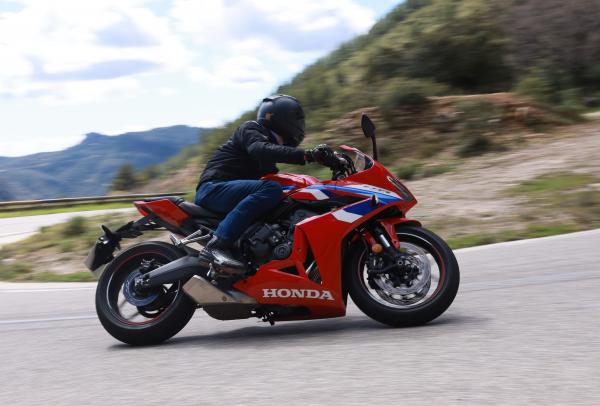
Honda’s sporty middleweight sticks to an old-fashioned recipe while mixing in the fascinating new E-Clutch system
When I first rode a Honda CBR650R, the bike didn’t have much competition to worry about. But in the intervening years, all sorts of sporty middleweights acting as indirect replacements for dead supersports screamers have changed the landscape massively.
On the more focused end of the spectrum, there’s the Yamaha R7. Aprilia’s RS660 is still around and better than ever thanks to some updates, while Suzuki has stuck a fairing and some separate ‘bars on its GSX-8S to make the GSX-8R. And finally, there’s the Triumph Daytona 660 in the mix, providing a three-cylinder riposte to the 270-degree crank parallel twin crowd.
So where does the CBR650R fit into all this? Is it still relevant, with its more old-school, high-revving inline-four? Looking at the sales figures, you’d have to say yes, but Honda can’t rest on its laurels when the competition is heating up, and so, there’s an updated version of the bike for 2024. Plus, it has a trick up its sleeve to separate it from the rapidly increasing middleweight crowd - E-Clutch.
What is E-Clutch, anyway?
Honda describes it as mixing together elements of a conventional manual transmission, a quickshifter and its dual-clutch transmission. It uses a pair of small motors to actuate the clutch plates based on various parameters including shift lever pressure, throttle position and wheel speed, so although it has a conventional, cable-operated clutch lever in the usual place, you don’t have to use it for pulling away, coming to a stop or changing gear.
Now, changing gear without a clutch is nothing new, but E-Clutch has some advantages over a bog-standard quickshifter, too. It reduces shift shock massively, making for smoother changes. The cog swaps are also 20 per cent faster.
E-Clutch is a tempting option for numerous reasons. Perhaps there’s a medical reason why you have difficulty with a clutch lever. Maybe you do a lot of urban miles, or maybe you just can’t be arsed with using a normal clutch. It’s not like it’s a fun aspect of biking after all.
There’s a final aspect working in E-Clutch’s favour - it’s cheap. Speaking of…
2024 CBR650R E-Clutch pricing, availability and colours
The bike is available to order now alongside the closely related CB650R with first deliveries landing in April 2024. The starting price is £8,599, with the E-Clutch version coming in at just £8,699. Yep, just £100 more. If you bought the regular manual and put a quickshifter on it, you’d end up paying a good chunk extra over the E-Clutch bike. Interestingly, the E-Clutch premium charged by other markets is typically more like the equivalent of £300.
The colour choice is…limited. You have red, or, erm, black. Or to give them the official names, Grand Prix Racing Red Tricolour, and Matt Gunpowder Black Metallic. We’d have ours in red - the black is just a bit subdued in the metal/plastic.
What else is different about the 2024 CBR650R?
Aside from the addition of E-Clutch, the CBR650R gets a raft of tweaks, many of them shared with the CB650R. Although not immediately obvious, it’s had a nip and tuck, with new headlights and rearranged vents on the fairing. It looks sharper than before, but it’s not a night and day difference.
The suspension hardware is much the same - you get a non-adjustable 41mm Showa separate function fork at the front with 120mm of travel, and a pre-load adjustable monoshock at the back with 130mm of bounce. The spring rates are new, though, and the compression damping has been firmed up slightly.
The dated LCD of the old bike has, thankfully, been binned. In its place is a much clearer colour TFT shared with all sorts of other Honda machines including the XL750 Transalp. It’s operated using new switchgear.
What’s it like to ride?
This is something we have to approach in two parts. As we did when talking about the CB650R, we’re going to start with the E-Clutch stuff.
Initially, you have to internally scream at yourself not to pull the clutch lever as is instinct. It’s with some trepidation that you first knock it into first gear with the left-hand leaver left alone, half expecting the bike to stall and awkwardly rock forward. But such worries are unfounded - first gear is selected with no dramas whatsoever.
With no need to feather the clutch, you simply start twisting the throttle, and unlike in a DCT-equipped Honda - which tends to slip its clutches quite a bit before engaging - the response is very eager. It’s maybe a bit too keen off the line, but you soon get used to it.
Surprisingly, you also very quickly get used to not yanking the clutch. I thought I’d be mistakenly reaching for it many times, but that only happened once across a day of riding on one bike. The reason is because of just how refined the system is - when you’re filtering through traffic and constantly stopping and starting, the E-Clutch is so smooth that you find yourself happy to let it do its thing.
Gear changes are indeed brilliantly quick and silky smooth, but not entirely seamless, since the system is still cutting fuel flow and fiddling with ignition timing. And so, it remains an engaging way to swap cogs, unlike a DCT whose even smoother shifts take some of the fun out of it all.
Away from E-Clutch, the riding experience isn’t all that different from before. It was, at least, interesting to start on a CB650R and switch to the CBR on the twistiest part of the route, highlighting just how much difference the riding position makes to the way the bike feels.
Yes, the CBR’s clip-ons are set fairly high, but you’re leant forward enough to put a good chunk more weight over the front end, making the bike feel more dynamic and confidence-inspiring. You’re more likely to brake that little bit later and tip in more aggressively on this than the CB.
As before, the CBR650R exhibits a feeling of suspension plushness that belies the lower-end components used by the chassis. Honda has tuned the system brilliantly, offering a deft balance between composure and comfort. Yes, there are more focused alternatives, particularly the Yamaha R7, but for many riders, the CBR will do all they need it to on a twisty road, or even a track.
There’s a simple traction control system (or ‘Selectable Torque Control as Honda insists on calling it), which is easily turned off with a long press of a dedicated button on the left switch cube, should you wish. The brakes offer plenty of stopping power, meanwhile, and a reasonable amount of progression at the lever.
The engine is what really sets the CBR650R apart from its competition, in both a good and a bad way. Many will love its old-school, screaming nature - enhanced by new intakes - but it is starting to feel like something from a bygone era. Yes, it’s more flexible than something like the reworked lump in the CBR600RR, with enough low-down torque to ensure you can happily biff around in higher gears, but it only truly thrills when you’re hunting down the 12,500rpm redline.
Peak power only comes in 500rpm before that, so you do need to be giving it the berries for the CBR650R to feel truly fast. With 94bhp to its name, it's more powerful than a lot of its rivals, but for a lot of the time, you wouldn’t really know it. What’s great about the twin and triple-powered alternatives is they sound great and have bags of character whatever engine speed you’re at.
Should you buy a CBR650R, and should you spec E-Clutch?
The first part of that question is now quite tricky to answer, given how many more alternatives there are to this bike compared to when it was first launched. It feels like one of the more ‘safe’ and less exciting choices in the class, but perhaps that’s not such a bad thing, especially if it is a high-ish-revving four-pot you’re after. After all, you’re getting Honda build quality, reliability and dealer back-up in with the bargain.
E-Clutch does also give the CBR650R an interesting edge over rivals. It’s brilliant for urban riding and is a great option for those who for whatever reason struggle with a normal clutch lever. Given that you only need to pay an extra £100 to spec E-Clutch, why wouldn’t you?
For the first application of the system, it’s incredibly refined, and will only get better as Honda inevitably tweaks it over the next few years. It’ll also almost certainly crop up on other bikes, and we’re all for it.

